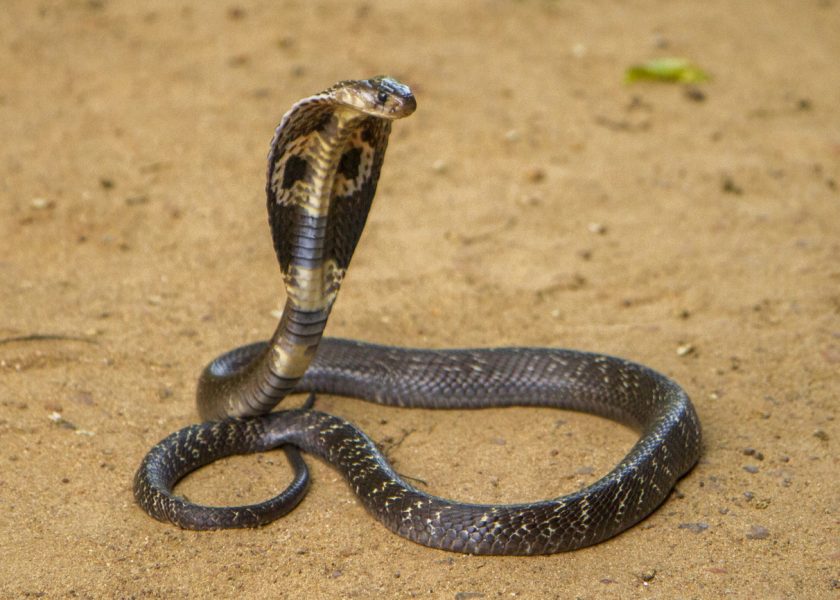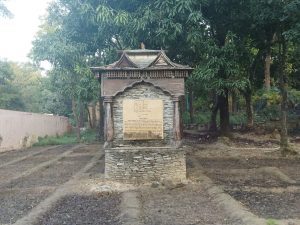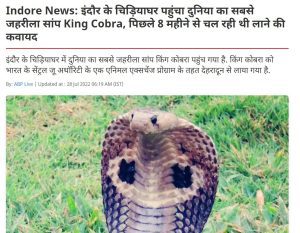
Where did the king go? Dehradun zoo and the mystery of the missing cobra
A 'vulnerable' snake's story — its zoo housing, relocation, disappearance and reappearance without proof, and the sudden surfacing of some proof — can give any thriller a run for its money. But the climax is yet to be unveiled

Sometime this May, Pankaj Pokhriyal, an animal rights activist working in Dehradun, was contacted by a resident about a snake that had strayed into his backyard. Pokhriyal is often swamped with such requests for help. A couple of snake rescuers were immediately called to the scene. These rescuers are often hired by the forest department to rid human habitats of unwanted serpentine guests and help the snakes find their way back into their natural habitat.
The rescuers who had come with their usual paraphernalia — a long stick and a bag — soon got down to work. As they nudged the snake out of hiding and deftly guided it into the bag, Pokhriyal, who was present at the scene and watching the whole process, generally asked them: “What are you going to do with it? I hope you release it back into the jungle. Or do you just abandon such snakes, or sell them?”
There was a reason behind Pokhriyal’s cheeky question. The wildlife activist has had several run-ins with the forest department and zoo authorities over “their insensitivity towards wild animals.”
Features: So you thought King Cobra is a single species? Study proves otherwise
Pokhriyal was surprised when the rescuers said they would neither release it in the wild nor sell it (“of course, not”). “Arrey sahab, these rescued snakes will become the food of the king cobra in the zoo.”

Now, Pokhriyal was well aware that the king cobra usually eats other snakes, even venomous ones. What he wasn’t aware of was that there was a king cobra in Dehradun zoo.
Monkey business
Coincidentally, around the same time, Pokhriyal, who was trying hard to rehabilitate a rescued blind monkey in Dehradun zoo, again had a run-in with the zoo officials.
After spending considerable time trying to convince them to provide suitable refuge to the blind monkey, Pokriyal was left exasperated. “They had thrown the blind monkey into a room and bolted the door from outside. When I tried to make them understand that the animal is blind and may hurt itself badly if kept in captivity or may even die of shock, they started arguing. I was just requesting them to keep the monkey in an open enclosure along with other animals in the zoo,” Pokriyal told The Federal, still fuming over the monkey incident.
What really got his goat was when one of the officials, according to Pokhriyal, said: “There are so many monkeys, one less won’t make this world poorer.”
When the zoo officials refused to transfer the monkey to an open enclosure after considerable pleadings and negotiations, Pokhriyal ended up using an important piece of information to win the argument. “You have the wherewithal to keep a king cobra illegally and feed it snakes but can’t help a poor monkey… Do you even have the permission to keep it?”
Until then, Pokhriyal had just had a hunch that the zoo authorities never acquired the required permission on paper from the Chief Wildlife Warden and the Central Zoo Authority to keep the king cobra on display.
Also read: Kangaroos in Bengal, and the sordid tale of exotic pets trafficking
Avoiding an escalation of the situation, Ranger Mohan Rawat and his staff started to walk away from Pokhriyal and slither into their office cabin.

Now, Pokhriyal got emboldened and charged them point black. “Show me the papers (permission documents) or I’ll expose you guys. Just wait for my mails [e-mails he later shot to senior officials, including the zoo director].”
Failing to elicit any positive response from the ranger, Pokhriyal left the zoo premises. A few days later, the king cobra disappeared from the zoo. “It was gone… just like that,” Pokhriyal told The Federal.
The rescued “son”
“It was like our beta (son),” said ranger Rawat. When asked how their beta (king cobra) slithered into the zoo in the first place, he told The Federal that it was a rescue.
“It was brought to us after being rescued from somewhere nearby and, as is the general process, it was kept under medical observation before being released back into the jungle once deemed fit,” he added.
But once the king cobra entered the zoo, it seems the “general processes” were thrown out of the window. Instead, the serpent was kept in the zoo, by the ranger’s own admission, for nearly two years until early July 2022. What’s more, it was also put on display for visitors in the serpentarium along with other snakes.
All this while, none of the zoo authorities thought it important to get any permission on record. According to the Recognition of Zoo Rules, whenever a zoo shall decide to accept any rescued animal for housing, a detailed report regarding the source from which the animal has been received, legality of its acquisition, and the facilities available at the zoo for housing, upkeep, and healthcare shall be sent to the Chief Wildlife Warden of the state. Provided that, in case the rescued animal pertains to an endangered species, a copy of the report shall be sent to the Central Zoo Authority.
Also read: Illegal trade in exotic animals booms as Indian ‘pet lovers’ go wild
In India, the king cobra has been listed as “vulnerable” on the IUCN Red List since 2010 and placed under Schedule II of the Wildlife Protection Act, 1972.
However, Ranger Rawat and Deputy Ranger Vinod Lingwal admitted to The Federal that “they don’t have anything on record to show that any of the procedures required for accepting a rescued animal for housing or releasing was followed”. Their logic: “Since we never intended to keep it forever… it was a rescue and initially we kept it under observation.”
On being asked why it was kept for two years and put on display, Rawat said: “It was so beautiful, you should have seen it. It was quite popular among the visitors as well.”
According to a senior official in the forest department, there is danger in keeping a rescue for long because it may get habituated to that place; it should normally be released back into the jungle once it’s found to be medically fit. “If they intend to house it in a zoo, necessary permissions have to be taken. But who follows any rules these days?” he said, requesting anonymity.

While the two officials continued with their imprecise answers, visitors who earlier saw the king cobra on display in the serpentarium can now see a chequered keelback snake housed in that enclosure. Rawat and Lingwal pointed out that visitors would be mesmerised by the sight of the king cobra climbing up the glass walls of the enclosure in its full glory. “It would stand up and look grown-ups in the eye. What a sight that was!” said Rawat.
The mystery deepens
So, where did the king go?
“We have released it in Rajaji Park,” Rawat said calmly.
And that is where he tied himself in knots. When Dehradun-based News 18 journalist Sunil Navprabhat asked Rawat if he could prove the snake was indeed released into Rajaji National Park (also in Uttarakhand) in July, Rawat initially claimed he had “papers” of its release but failed to show any to support his claim.
Following media reports, Uttarakhand Forest Minister Subodh Uniyal ordered an inquiry into the missing king cobra that was housed in the zoo since early 2020. Wildlife Warden Sinha further instructed the zoo director to furnish a detailed report.
Meanwhile, Pokhriyal, too, wrote an email to Dehradun Zoo Director Nitish Mani Tripati, requesting him to provide information about the shifting of the king cobra from Dehradun zoo. But he hasn’t received any reply so far.
The Federal Premium: The road to return of the cheetah is strewn with landmines
Rawat admitted to The Federal that everything was done verbally and there was no written record — neither of housing the snake in the zoo nor of its release into the jungle.
But why did they release it, if at all they did, suddenly this July?
“Some animal rights activists were unhappy over the issue. When they started a hullabaloo, we thought we did not want to keep it (the snake) by upsetting anyone,” said Rawat. “We immediately took it off display.”
However, he said, the snake was first kept in a peti (box) and then released (of which he has no proof).
The Federal has accessed a video where the king cobra can be seen getting a quick bath in the zoo premises and quickly put inside a wooden box. Zoo insiders say the snake was packed off to some city after that. The Federal, however, was not able to independently verify the authenticity of the footage.
By now, the two officials — the ranger and his deputy — looked a tad nervous. Their usual calm was gone. One of them almost bit his tongue as he blurted out “Our only fault was that we kept it and cared for it…it was like our son.”
Indore “fake news” mystery
Trouble mounted for Rawat and others once news spread that the king cobra may have been translocated to Indore instead of being released into the jungle.
Sunil Navprabhat, who first broke the story of the missing king cobra, also reported that the same snake may have been translocated to Indore zoo (Kamla Nehru Prani Sangrahalaya). “Around the time it disappeared from here, media reports in Indore said the Indore zoo got a king cobra from Dehradun zoo in an exchange programme.”
Also read: King cobra hitches ride in car for over 200 km in Arpookara in Kerala
Rawat denied it as “ghalat khabar (fake news).” Both he and Lingwal claimed there has been no exchange of any animal ever between Indore zoo and Dehradun zoo, earlier known as Malsi Deer Park.

However, some media reports quoted Indore zoo in-charge Uttam Yadav as saying that this was for the first time that a king cobra was brought to Indore zoo. “The 13-ft snake arrived at the zoo at 12 noon (Wednesday, July 27), and it will be kept at the zoo’s snake house,” he was quoted as saying by The Times of India.
The same report also said that the king cobra had been brought from Dehradun as part of an animal exchange programme of the Central Zoo Authority of India. Indore zoo authorities were in the process of bringing the big snake for the past eight months or more. It arrived around 1 pm on Wednesday. In return, the zoo gave four pairs of gharials to Dehradun zoo, the report added.
Also read: A stranded lone vulture, and its relocation from TN to Rajasthan
The trail gets more muddled from here. When The Federal contacted Uttam Yadav, he, too, denied there had been any exchange programme between the two zoos. “The king cobra that we have is a rescue and it has been in our zoo for almost one-and-a-half years now.”

When asked about the news reports in Indore media, Yadav’s reply was in sync with Rawat. “Total fake news. We can’t control what the media writes,” Yadav insisted over the phone.
However, the Kamla Nehru Prani Sangrahalaya (Indore Zoo), in its 2020-21 compliance report (compliance with conditions stipulated by the Central Zoo Authority), mentioned that it had already started working on transferring surplus animals (gharials) to other zoos or their natural habitat. “Gharials as part of animal exchange programme approved by the CZA were shifted to Dehradun and Nandankanan zoo this year. Other proposals shall follow soon,” the report said.
On the other hand, the annual report of Dehradun zoo 2019-20 mentions that although the “exchange of animals with other zoos was not done, four gharials (2:2) were acquired from Kamla Nehru Prani Sangrahalaya Zoo, Indore.”
However, deputy ranger Lingwal contradicted this in his comments to The Federal. While talking about the reported exchange programme with Indore zoo, Lingwal categorically said: “I have been posted here for five years now. No animal has ever come from Indore zoo to Dehradun zoo.”
Overnight proof
While journalists, wildlife activists, and animal rights crusaders on the hot chase of the king cobra so far haven’t been able to crack the mystery, insiders in the forest department privy to the ongoing probe said the zoo authorities now have “documents to prove the release of the king cobra into Rajaji National Park.”
Also read: Cheetahs: Their Mughal connection, and how they went extinct in India
“They have been building pressure on a few zoo staffers to sign documents prepared now. Some of them had initially refused to sign the papers but may have succumbed to the pressure,” said a source in the know.
In all this, the only person who agreed to come on record about the release of the king cobra into Rajaji National Park was the snake specialist who works with Dehradun zoo on a contractual basis. “Yes, I was there while the king cobra was released into Rajaji Park,” he said, requesting not to be named.
Also read: Fishing by trawlers main cause of decline in sea snake population
Meanwhile, the rest of the people, including animal rights activist Pokhriyal and journalist Sunil Navprabhat, are all waiting with bated breath for the probe report to be made public.
The king cobra’s stint in the zoo has left many unanswered questions.
First, why was it housed in the zoo for nearly two years without the authorities acquiring the required permission on record?
Second, the zoo authorities claim there has never been any exchange programme between the two zoos in the past. Then why do their annual reports of the previous years say otherwise, even if unrelated to the king cobra’s “disappearance”?
Also read: Jairam Ramesh shares the inside story of cheetahs’ homecoming
Third, Ranger Rawat admitted to The Federal that there was no written record of the permission taken but if they show it now, how did they manage to do it?
Lastly, why was the serpent released into the wild in a hurry if everything was above board?
When asked about the status of the ongoing probe, zoo director NM Tripathi told The Federal that the report was almost ready and would be submitted anytime soon. “Once submitted, the media will get answers to all their questions,” he claimed.

